|
[Front Page] [Features] [Departments] [Society Home] [Subscribe]

First Cuttings
Australian Plants Societies
Australian Plants online is brought to you by the 7 Societies that make up the Association of Societies for Growing Australian Plants (ASGAP).
Have you ever thought of joining one of the Societies? There is a Regional Society in every Australian state and also in the Australian Capital Territory. In addition, there are over 100 district groups established in centres throughout Australia.
Membership brings many benefits - regular district group and Regional newsletters, the colour journal "Australian Plants", access to free seed banks, regular meetings with expert speakers, bush walks, garden visits, advice from experienced growers, access to difficult to obtain plants and access to Study Groups.
Why not take a look at the Membership Page and see what we have to offer?

The "Gumnuts" Newsletter
Gumnuts is an email newsletter on Australian native plants which is published 4-6 weekly. It covers a wide range of topics - limited only by the imagination of its subscribers.
To subscribe - please see the "Subscribe" section of the current issue.
You may unsubscribe at any time.

Salt Sensitivity Database
The Australian Biodiversity Salt Sensitivity Database contains information on the sensitivity and tolerance of over 1200 species of Australian taxa to salt. The database is supported by interpretive notes and a statistical analysis of species groupings.
The Salt Sensitivity Database includes:
- A methodology report and references
- The salt sensitivity database as an Excel spreadsheet
- A set of graphical analyses of field data for major taxonomic groups, and summary notes accompanying text providing interpretation of field and laboratory/glasshouse data for major taxonomic groups (included in Excel spreadsheet).
The database. methodology report and references are available for download Land and Water Australia's River Landscapes site.

Acacias - Bridging the Knowledge Gap
CSIRO Publishing has released a publication that will narrow the significant gap in scientific knowledge about one of the world's most important genera of woody plants - Acacias.
The publication contains the 13 papers that were presented at the Fourth International Legume Conference in Canberra in 2001. Each paper highlights a current issue in acacia research, recent breakthroughs and the challenges researchers expect to face in the future.
According to the co-editor of Biology of Acacia - Advances in Legume Systematics Series Part 11, Graham Stone, University of Edinburgh, the current lack information about this important genus of plants is puzzling.
"Given that the foliage, fruits, wood and bark of many acacias have been used by humankind for centuries as fodder for livestock, sources of famine food, medicines and fuel, it is incredible how little we know about the vast majority of acacias," says Dr Stone.
"The ecological and economic importance of acacias means that biologists must rise to the challenge of combining science and management to maintain what is valued, and control what is not," he says.
Issues covered in the publication include: the generic status of acacia; the domestication and use of Australian acacias; and, the implications for genetic diversity of utilising acacia species in agroforestry.
The publication is a special issue of the Australian Systematic Botany journal, and forms part of a long-running series published by Kew Gardens in England.
Copies are available by contacting CSIRO Publishing on either: Freecall 1800 645051 in Australia; +613 9662 7666, email: publishing.sales@csiro.au; or by visiting: www.publish.csiro.au
CSIRO Media Release

| |
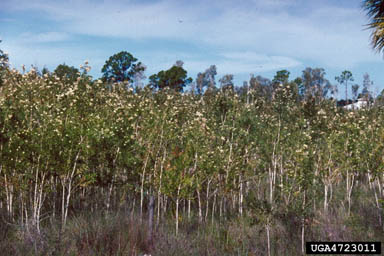 |
| |
Melaleuca quinquenervia in Florida: Flowering sapling representing early invasion stage in seasonally flooded habitat.
Photographs by M.Rayamajhi and W.Durden. |
| |
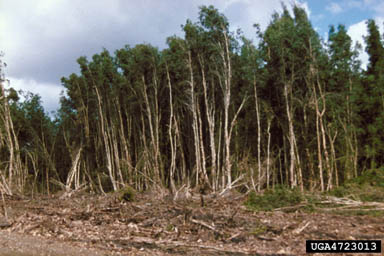 |
| |
Melaleuca quinquenervia in Florida: Vertical section of a stand in seasonally flooded site in the Everglades.
Photographs by M.Rayamajhi and W.Durden |
Broad-leaved paperbark (Melaleuca quinquenervia) is a widely planted and much loved native tree. It is the typical "paperbark" that can be found planted in public and private gardens in many parts of Australia.
It may come as something of a shock, however, to discover that the plant has a darker side - the invasion of broad-leaved paperbark into wetlands of south-eastern USA has been well documented but probably nowhere in as much detail as on this site.
The site is the work of the University of Georgia - Warnell School of Forest Resources and College of Agricultural and Environmental Sciences - Deptartment of Entomology.
If ever there was a lesson to be learnt about the dangers of introducing species into areas outside their native habitat, Florida's experience with M.quinquenervia is it. The situation is so serious that Florida state laws enacted in 1990 and 1993 prohibit the sale, cultivation, and transportation of M.quinquenervia. The species was placed on the United States Department of Agriculture's Federal Noxious Weed List in 1992.
The information contained on the site looks at wide range of topics including:
- Distribution and natural habitat
- Taxonomy and biology
- Pest status
- Ecological and economic damage
- History of biological control efforts
- Biology and ecology of natural enemies
- Releases of biological agents
- Establishment and spread of agents
A somewhat curious statement on the site is that "M.quinquenervia ..... is considered threatened in its native Australia." This is incorrect. The plant has a wide distribution from southern New South Wales to Cape York and is not considered to be at risk in the wild.
Photographs from Invasive and Exotic Species of North America

Drought Takes Toll on Biocontrol
The moths, weevils and beetles which play a vital role in Australia's war against weeds are suffering severely in the current drought.
Along the NSW coast a struggle is taking place between a tiny introduced moth and one of Australia's most invasive weeds, bitou bush.
CSIRO's Anthony Swirepik says that the latest bitou biocontrol agent, the leaf-rolling moth Tortrix, has not established as well as predicted in its two years since initial release.
"Bitou along the coast is being affected by the dry conditions, and this affects the biocontrol agents that attack it. The leaves of bitou bush become tough and lose nutritional value. This makes it very difficult for the young larvae to get a niche amongst the growth tips."
"We're also finding ants and spiders are decimating some of the releases we made late last year," he says. "Ants and spiders are looking for insects to eat, which have become scarcer in the drought. Then scientists provide a 'food parcel' of 10,000 leaf-rolling larvae and the ants and spiders have a feast, wiping out the larvae that are meant to attack bitou.
There is some good news: there are two sites where the moth has actually increased in numbers: La Perouse (Sydney) and Broilers Pt (Wollongong). These sites are similar in habitat, headlands rather than sand dunes, and the populations of leaf rolling larvae have doubled at both sites since winter, from an average population of 10 larvae per m2 to 27 per m2.
Mr Swirepik believes that the reason for the success at these sites may lie in the soil type, making the bitou more palatable and nutritious to the leaf-rolling larvae, and the protection provided by the prevailing winds from other insect predators.
Meanwhile, two other biocontrol agents released prior to Tortrix are faring a little better. Like the leaf-rolling moth, the tip moth, Comosotolopsis germana, (first released in 1990s) has also suffered from attack by native predators at the sand dune sites, but populations at headland sites are well established and causing reduction in seed set of up to 80%.
The seed fly, Mesoclanis polana, is responsible for reducing seed production by approximately 30% at all monitored sites where it has established.
Mr Swirepik says that once the leaf-rolling moth becomes established it will dramatically reduce the growth rate of the weed and complement the impact of the other two agents in reducing seed production and biomass of this Weed of National Significance.
"It's two steps forward, one step back with this weed, but we're confident we'll eventually get the upper hand," he says.
CSIRO Media Release

This new site features seasonal weather calendars, developed over thousands of years by Indigenous communities.
The site is in its early stages of development and currently features information for three areas in the Northern Territory. It will be progressively expanded to include information for additional areas.
The traditional European approach of four distinct seasons was imposed when Europeans settled in Australia. However, Aboriginal calendars recognise the complexity and diversity of weather over the Australian continent and are finely tuned to local conditions. They may recognise as many as six distinct seasons.
The website is the result of a joint effort involving the Indigenous communities, Aboriginal and Torres Strait Islander Commission (ATSIC), the Bureau of Meteorology, and Monash University's Centre for Australian Indigenous Studies and School of Geography and Environmental Science.

WATSNU is a newsletter published by the Western Australian Department of Conservation and Land Management (CALM). It contains information on threatened species and ecological communities and is produced two to three times per year and provides:
- updated information on threatened plants, animals and communities, including recent discoveries
- summaries of Recovery Team annual reports
- information on animal and plant translocations
- descriptions of approved guidelines and policies affecting threatened plants, animals and communities
There is a form on the site to allow you to subscribe to the WATSNU Mailing List. This provides an email notification of the availability of WATSNU, as well as other late-breaking news on saving threatened wildlife.

Sammy Ringer started Bushfoods magazine some years ago as a specialist hard copy magazine aimed at the Australian food plants industry and consumers. As of issue 19, the magazine is no longer produced in hard copy format but is a fully electronic publication.
Issue 19 is now on line and includes:
- Davidson plum
- FAQ
- Dorrigo Pepper
- Kakadu Plum
- Wild Fruits
- Fertilising
- Essential Oils
- Acacias
- Bushfood suppliers and products
- Medicinal
- Nurseries
Hard copies of back issues are still available through the site.

"Australian Plants"....in print!
The Society's 48 page, colour (printed) journal, "Australian Plants" has been published quarterly since 1959. It carries articles of interest to both amateur growers and professionals in botany and horticulture. Its authors include the leading professional and amateur researchers working in with the Australian flora and many beautiful and high quality photographs of Australian plants are published in its pages. Topics covered by the journal cover a wide range and include landscaping, growing, botany, propagation and conservation.
A subscription to the print version of "Australian Plants" is $20 annually for 4 issues (overseas $AUS32) including postage. To subscribe, print out the Subscription Form and post or fax the appropriate fee to the address indicated on the form.
Note that the contents of "Australian Plants" and "Australian Plants online"
are totally different.
These are some of the topics covered in recent issues of "Australian Plants":
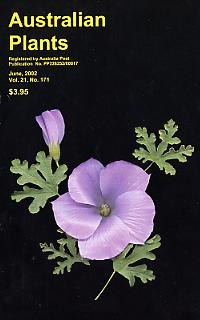 |
Issue 171: June 2002
Contents
Alyogyne - An Update
Cuttings - a Commercial Choice
Calostemma purpureum
Melaleuca for the garden
Bracteantha Micropropagation
Trigger-Plants, a book review
Serendipitous Science
Asterolasia buxifolia, rediscovered 160 years later
Flindersia revisited
Cypress Pine Forests
Hardy Cultivars from Nellie Nursery |
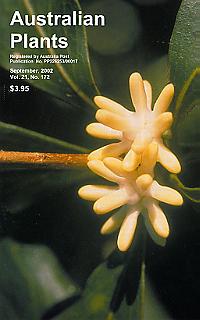 |
Issue 172: September 2002
Contents
Growing Rainforest Plants
Eidothea hardeniana - Botany and Ecology of the 'Nightcap Oak'
Propagation of the Nightcap Oak
Book Review: Mangroves to Mountains
Brachychiton bidwillii: An Under-exploited species
Some Southern Rainforest Plants
Our Garden, Number 38
A Rare Honourfor Gwen Harden
Book Review: The New Nature
Cultivation of Stenocarpus species
Opisthiolepis heterophylla
Opisthiolepis heterophylla postscript
Tropical Waterlily - Nymphaea gigantea |
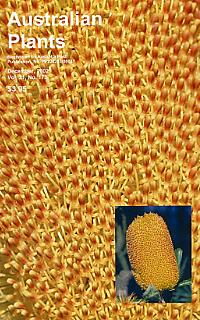 |
Issue 173: December 2002
Contents
Banksia in Horticulture
'Robyn Gordon' Grevillea Complex
Some Rainforest Grevilleas
Our Garden, Number 39
Bill Payne - An Acknowledgement
Olearia viscosa
Xerochrysum the Correct Name for the Genus Bracteantha
Book Review: Starting Out With Natives: Easy-to-Grow Plants for Your Area
Kunzea baxteri
Banksia tricuspis
Update on Blandfordia |
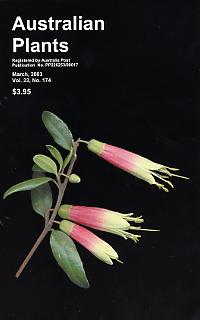 |
Issue 174: March 2003
Contents
The Correa Study Group
The Correa Lover and the Artist
Correas Make for Happy Memories
Katandra Gardens - A Home for Correas
Nangawooka - Land of Springs
Botanical List of Correa Species and Varieties
Descriptions of the Species, Varieties and Cultivars
Grafting Correa
Correas as Potted Colour |

Brian Walters
Editor
[Front Page] [Features] [Departments] [Society Home] [Subscribe]
Australian Plants online - June 2003
Association of Societies for Growing Australian Plants
|